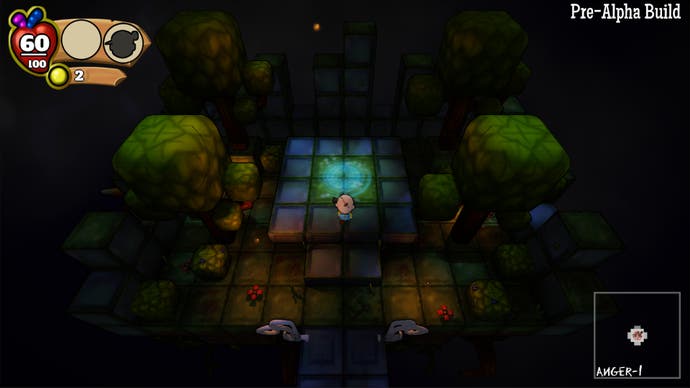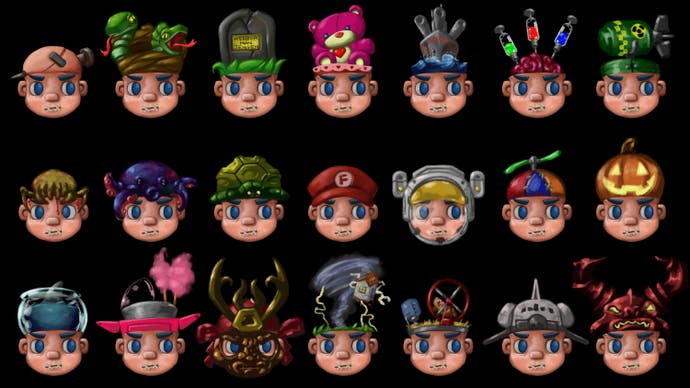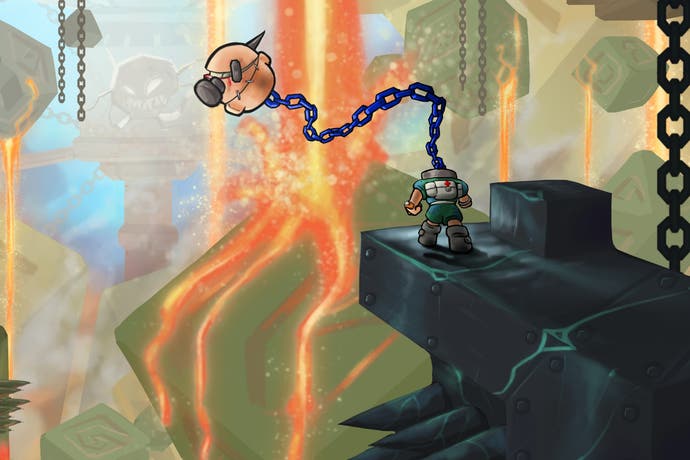FranknJohn, the brawler that requires skulls as well as skills
Mind your head.
Let me be Frank. And John. Actually, let me be FranknJohn (the head of the former and the body of the latter), a bizarre post-human experiment who wakes up with no knowledge of his horrible purpose, and then sets off to find out who he is and why he came to be.
This is the macabre, Mad Magazine premise for BitSmith Games' new project - a twin-stick roguelike brawler. That's a strange muddle of genres indeed. That's an idea that blends the voguish with the unexpected. The developer's evil overlord (his description) Owen Harris sees it another way too. "This has been my therapy," he says. Then he laughs, thankfully.
In fact, games have always been Harris' therapy. "Before we started BitSmith, back in my 20s, I had this huge body of work," he remembers. "Mods and things - but none of it was finished. I suffered from this kind of this chronic starting disorder. I started making new things - new things all the time. But I ended up with this hard-drive of games that weren't finished, artwork that wasn't finished, models that weren't finished. I probably even had a novel or two on there. Music, everything. I've always loved making things, but I was just terrible at seeing them through."

Hence the therapy. Forming BitSmith Games with a group of friends from the Dublin Institute of Technology's digital games MSc course, Harris became determined that the studio's first project would reach the point where they could, you know, put it on sale. "I was always trying to get things to a state where I would be okay with just showing them," he says, "so with Ku, we put our game up on our website after the first week of development. That broke that cycle. It meant I never had to bring things to the point of presentability. I just had to improve on what was already there. And for me, psychologically, that was really important."
Ku is actually Ku: Shroud of Morrigan, an ambitious action-adventure game drawing on Irish mythology, and filtered through Ireland's economic crisis. It's a fascinating piece of work, but Harris admits it's also a classic first project: filled with promise but lacking a little in implementation. Turns out there was more therapy to undergo.
"I guess it took us a really long time to finish the game and we just didn't test it enough," Harris sighs. "We became a bit precious about testing it and a bit scared about testing it. So to get around that with FranknJohn we brought a two week old build to GDC, and we got the lead level designer of BioShock Infinite to play it. The Team Meat guys played it, and we got a tonne of other people to play it and we've just been incredibly aggressive about testing it ever since. Whenever we tested Ku, I'd get very uncomfortable when things started to go wrong for people. Now, we're so early on in this game and it's all very different. When things go wrong for people, that's actually valuable information that we can use. It's not a qualitative statement about me and my life and my decisions."

A lot of this also comes down to the core differences between the games, of course. Ku was hand-crafted - filled with bespoke set-pieces and one-off art. FranknJohn's boldly procedural, and this informs the whole design. Once the team comes up with a single new enemy type, for example, they can stick it in and it will immediately populate all the levels. It's the kind of game that's fun to test.
And, judging from a very early build, it's going to be quite fun to play too. While Spelunky and The Binding of Isaac are the easiest associations to make, this is a true Frankenstein's monster of a project, with the various bits and pieces coming together to create something unique. FranknJohn himself's a compact, cartoony presence exploring 3D levels that are made from piles of blocks and which hang, precariously, in space, allowing you to see distant areas - and distant threats.
Your main attack comes from flinging your head out on a chain and butting foes. It's controlled with the right stick, but the shift from shooting to brawling means that the whole thing doesn't really fire up the same parts of your brain as a twin-stick shooter does: you need to think much more about how you're going to get in close, and you can't just rely on circling, churning, whittling away at enemies.
Stages are procedurally jumbled, but there are a handful of elements that always remain the same. Harris says that, when it comes to structure, "80 percent of FranknJohn's rooms are what we call arena rooms, which are basically smash stuff. 15 percent are collection rooms, where they're puzzling and platforming. Finally, we have narrative rooms that are much more rare. It's going to be there that we eke out the story of what's going on in this world. You'll be picking up the pieces as you go."

And that's not the only thing you'll be picking up. Patches - the game has a boy scout motif threaded through the design - allow for permanent character upgrades, while pills provide temporary boosts to things like speed and damage. Finally, there's the biggy: each level contains a huge contraption called a Head-a-Tron that swaps out FranknJohn's current head for another with a new power. Delivery of these heads are randomised, and draw from a pool of about 100. Some of them are really useful - one of them even turns the game into a genuine twin-stick shooter. Some of them, though, are an absolute disaster, making your character harder to control, say, or scaring enemies away and rendering them trickier to kill. Switching heads in the game - as in real life, I guess - is a decision you'll have to really think about.
As for BitSmith Games, the team has got plenty of other things to think about too as it races towards a Kickstarter in February of next year. Kickstarters, Greenlights - it's still hard for a small studio to make a name for itself these days. That said, there are enough reasons to think that FranknJohn may just have what it takes to keep its heads above the water.

